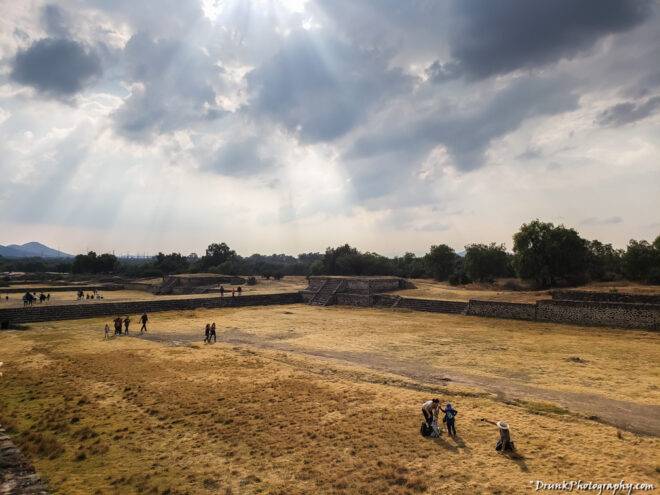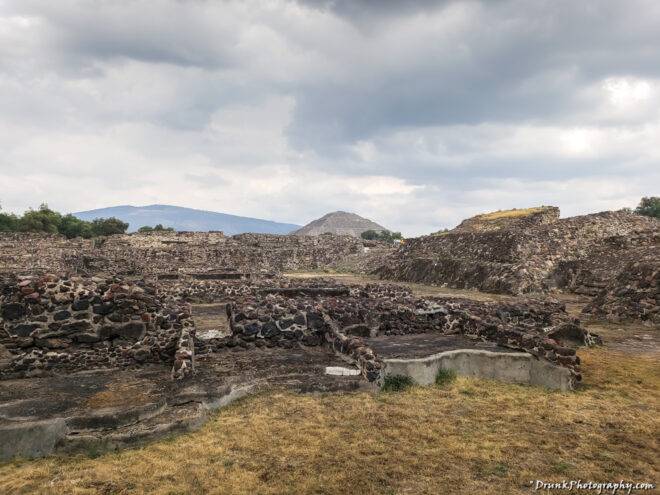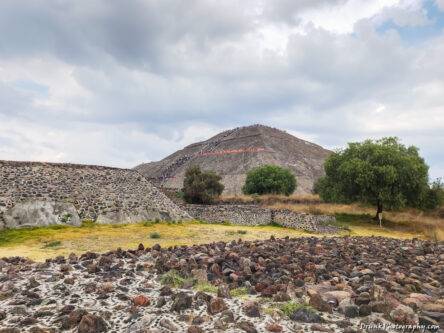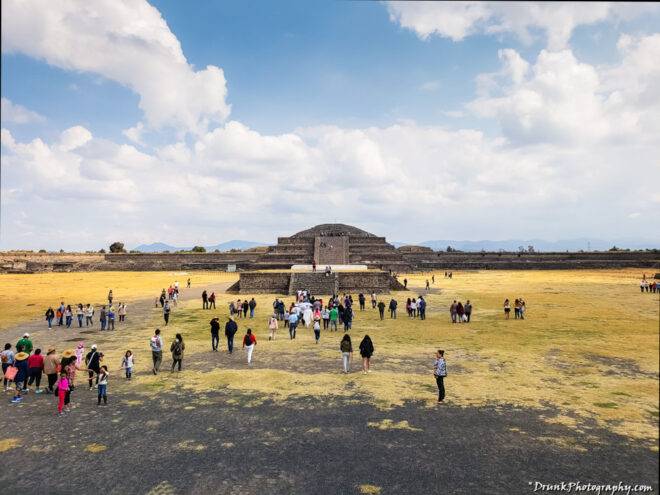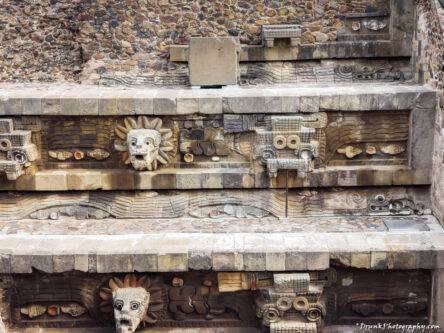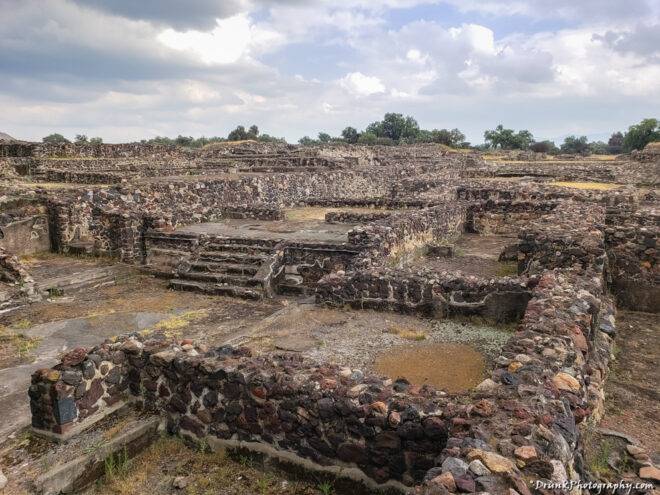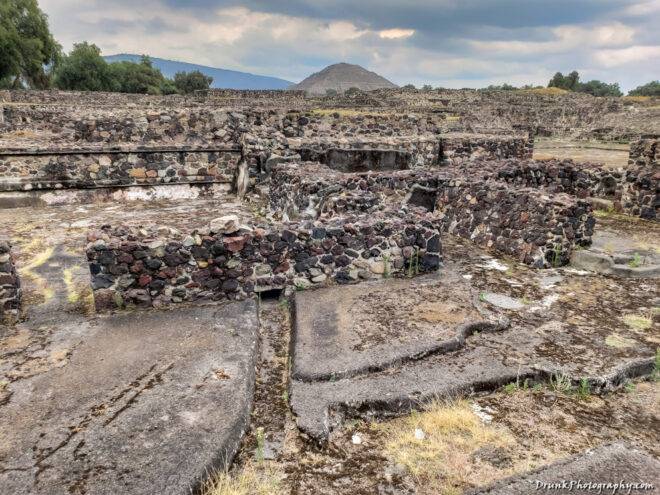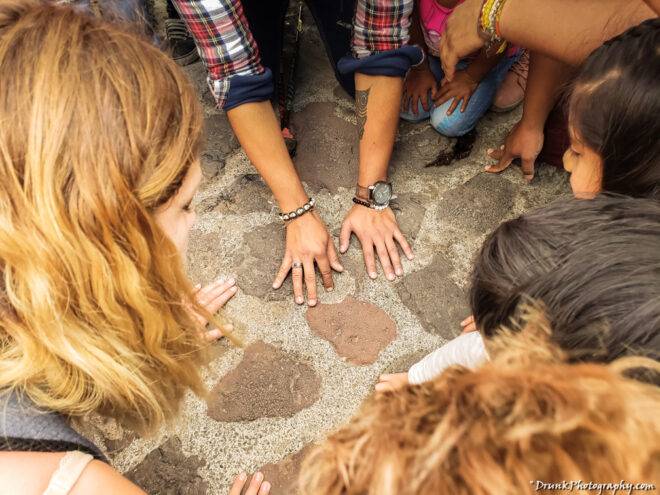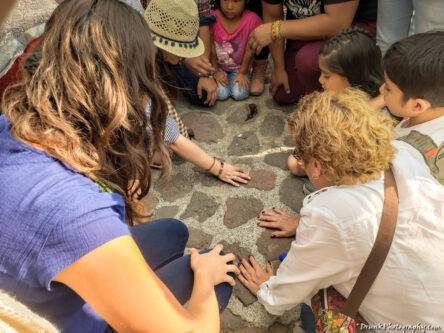Teotihuacán folklore
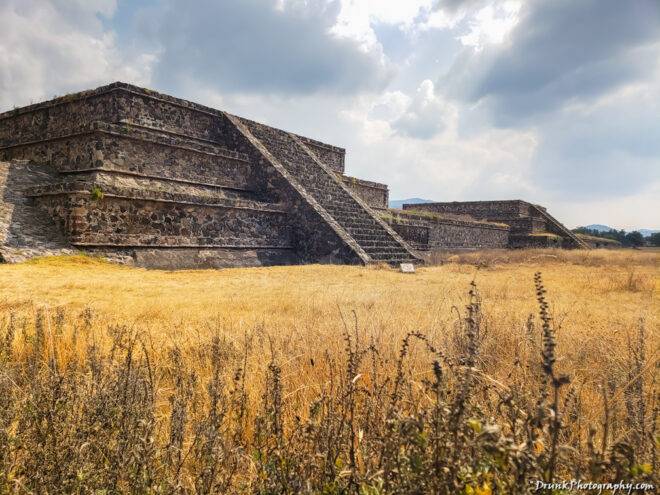
Teotihuacán
Teotihuacán del Valle, Chiapas, Mexico
Mind blown in Mexico
I was out at the pyramids of Teotihuacán, Mexico taking in the rich history of the location with a local guide. If you ever end up going to the Pyramids of Teotihuacán, you should hire a guide because the stories of the history of Mexico are excellent tales, and a major learning experience. If you go by yourself, you’re not going to understand the significance of everything around you. It is a huge error to make a Bee-line for the Pyramids only, which is what 99% of the people there did rather than viewing the WHOLE site, bypassing some of the most interesting things off to the sides of the site. While discussing this site with a few Mexican friends, whom went to this site many years ago, they seemed to not know about the “3rd Pyramid”, they only remembered 2 Pyramids (technically they’re right, I can explain later). Them looking at me like I never went to the site was pretty funny. Even funnier was me actually going to the site and explaining things they clearly did not see and didn’t know existed. Even after showing them the pictures, to prove that I wasn’t crazy, these guys were now convinced that they didn’t adequately view the site they were so proud of. I blessed them with some of the info that I learned, which went a little something like this… hit it..
Teotihuacán is a “MESOAMERICAN” city believed to be created and established between 100 to 400 Before Common Era, about 50 kilometers North of common-day Mexico City. Everyone debates the actual origin date, but it definitely falls in this range, with the site claiming by 200 BCE. The population, at its peak was 100,000 people and was the center of attention at its time, as many different cultures gathered that this location. There are many highlights but the most famous are the Avenue of the Dead, the Temple of Quetzalcoatl, the Temple of the Plumed Serpents (aka Feathered Serpents), Ciudadela, and the 2 (official) pyramids (Pyramid of the Sun, Pyramid of the Moon). The structures are connected by the Avenue of the Dead walkway. These structures began to appear by 300 Common Era, and it’s believed that it was abandoned by whomever originally created it (no one really knows who did it) by 700 CE. When the Aztecs found the site, it was deliberately destroyed (burned) to the ground, and it’s believed that either the poor people uprising were the culprits, or an invading force destroyed it.
Long before the Spaniard ever came to Mexico, the Aztecs occupied the city by 400 CE, and this is who is most notably associated with the site today, being the last major civilization to occupy the land, but they were not the ones who created it. They named it Teotihuacán (“The place where Gods were created)” which is their native language of Nahuatl. When the Aztecs found this 20 Square Kilometer site, it had been long abandoned for centuries. The site contains elements of cultures from previous civilizations like the Mayans, among others, it also contains where were various living quarters, and this is something that many people do not know because they don’t bother to go looking around the site, they just head right to the Pyramid of the Sun and then leave. Another great thing about having a local guide is that you get to hear the folklore behind the creation of the site, which is much more amazing that just rushing through the site and viewing it from an actual historic eye. The guide let us know some great insider info that is not if your pamphlet and ignoring Mexican folklore is robbing yourself of the experiences!
From FACT to FOLK
Teotihuacán is also known for its history of mass human-sacrifice and DEATH! You see locals selling statues and things representing death all day. The death was not done to be purely malicious, or at least not according to the ancient Mexicans ancestors. It was mostly human sacrifice. Human sacrifice also came with honor, like the adoration that goes to star athletes today, so too did it go to players of a popular Mayan game (referred to as “Pok a Tok”) . Pok a Tok was like a combo of soccer and basketball but obviously pre-date both, Aztecs changed it up and it was called “ollama” on a playing field tlachtli. That was definitely borrowed from Mayans. The victor of the game would be the one sacrificed to the Gods, not the losers, and over time only “nobles” could participate in it. You could also rob the spectators each time you scored (yes, ROB THEM OF THEIR POSSESSIONS) and there were structures dedicated to sacrificing people. Thousands and thousands of people were sacrificed left and right in the Aztec times, and the Aztec belief was that it was all to prevent the end of the world. They believed the end of the world was near and that “existence” was on its last leg. To delay this end, humans had to be sacrificed to the Gods. They believed that human existence was in its 5th cycle (4 cycles previously ended), with a corresponding new Sun in each, and this 5th Sun cycle was born in Teotihuacán. The 1st Sun God was Tezcatlipoca (Smoking Mirrors) and Giants lived in this era, but they met their end in the 2nd Sun cycle, as Jaguars were summoned to kill all Giants, by Quetzalcóatl (Plumed Serpent). Quetzalcóatl then ruled the 2nd Sun, until turbulent winds destroyed it, and all people were turned into Monkeys. The 3rd Sun was then ruled by the “God of Rain” Tláloc, but then that cycle was snuffed out by a hail of Fire, and all inhabitants were replaced by Birds. Tláloc’s sister Chalchiútlicue then ruled the 4th Sun, but that was flooded out of existence, as its inhabitants all turned to Fish. That’s an interesting “creationist” perspective. But now, there was no new 5th Sun, so the Gods met at Teotihuacán to pick the next God to lead the world into the new Sun, but the catch is that that God would have to sacrifice himself to reboot the new world. 1 God named Tecucistécatl immediately accepted the role, but no one wanted to be the second God in this world, so they chose one (Nanahuatzin), who reluctantly accepted the role. Nanahuatzin’s character is known as a sickly (tumorous figure) coward but also known as the Humble God, while Tecucistécatl was the Warrior God, strong, firm and proud.
Now the Gods were instructed to build huge fires to begin the world, so hot no one could get near them without being burned to death. They needed something to burn in the fire so they created their own fire-starters bundles. Both God made their fire starters differently: The Humble God made his bundle out of grass, hay and thorns, simple things. He squirted blood from his body to paint the collection red. Ancient civilizations believed in burning copal incense in sacrifice, Humble God burned his tumors from his body instead. The Warrior God went a different direction, he made bundle of only precious material, to fit his style. Instead of using grass, hay and thorns, he swapped them out for rare FEATHERS, GOLD and rare STONES respectively. He used thorns colored red for his coloring and he used copal incense that were the most expensive men could buy. The 2 Gods each built their own Pyramids and sat on them in preparation for the ceremony. The other Gods surrounded them, set their fire-starter bundles on fire, dressed the 2 Gods in the finest clothing and made them stand in front of their fires. The other Gods ordered the War God to get into the fire to sacrifice himself, but he tried many times and was so scared because it was too hot. Tecucistécatl, the Warrior God, chickened out! The other Gods now ordered the Humble God, Nanahuatzin, to get in and he just jumped right in, no hesitation! You didn’t see that plot twist coming, now did you?? After seeing the so called cowardly Humble God sacrifice himself, suddenly the Warrior God looked like a coward to all. Shamed, he now threw himself in the fire. An Eagle and a Jaguar came out of nowhere and followed the Warrior God into the fire an came out burned, which is why they believe an eagle’s feather has its pattern and a Jaguar is spotted. The other God’s waited for Nanahuatzin to be reborn, he was the most important for his bravery. The sky lit with colors and there was Nanahuatzin, the new world’s brand-new 5th SUN shining high in the sky to the east. Moments later, out came Tecucistécatl, but not in the form of a SUN, but in the form of a MOON. And for this reason, the ancients believe that is why the order of the Sun and the Moon are fixed. The bravest who sacrificed himself first, comes first. But both the moon and the sun shined equally as bright, despite their order, which was a problem, the brave should prosper.
One of the Gods saw a RABBIT running by and chucked it at the moon’s face forming a pattern, which soaked up a lot of the Moon’s light, making the Sun shine brightest. It’s funny that the Chinese have stories of a Rabbit on the Moon too ( Still, they didn’t move, they just remained in the sky. So the other guys, pleased with the new world, disappeared into the fires, 1 coming back as WIND, which finally moved the Sun and Moon in pattern of the Sun coming first, and the wind would blow the rotation of the Moon right after, and reset each day. Nanahuatzin had his named changed to Tonatuih. The Aztecs changed some of the myth around to make a new god, Huitzilopochtli (Hummingbird of the South) and he became the God of War, Human Sacrifice, because the Aztecs were a war tribe, they wanted that figure to be the Sun. To move the Sun and Moon, but to also gain energy to continue to win over enemies, Aztecs felt they needed to increase human sacrifice to keep the new world running, just as those God sacrificed themselves to make the Sun and Moon move through the sky. Humans had to repay the favor.
So, the point of that story was how you got the folklore behind the Pyramids and other structures at Teotihuacán, not just the scientific, historical reasons they actually exist. I think the folklore is equally impressive, because this carried through multiple civilizations whom supposedly were different groups, in different eras. This is the reason the Pyramid of the Sun (65 meters, 248 steps) was build higher than the Pyramid of the Moon (43 meters). Teotihuacán was a gathering place for a lot of different groups coming together under one city, much like a city today would be inhabited. When people arrived, or dispersed, they either brought or took some of that knowledge and culture with them. This is how a lot of the stories all over North, Central and South America might seem the same or related. These are the stories that make Folklore.
TEMPLE OF THE PLUMED SERPENT
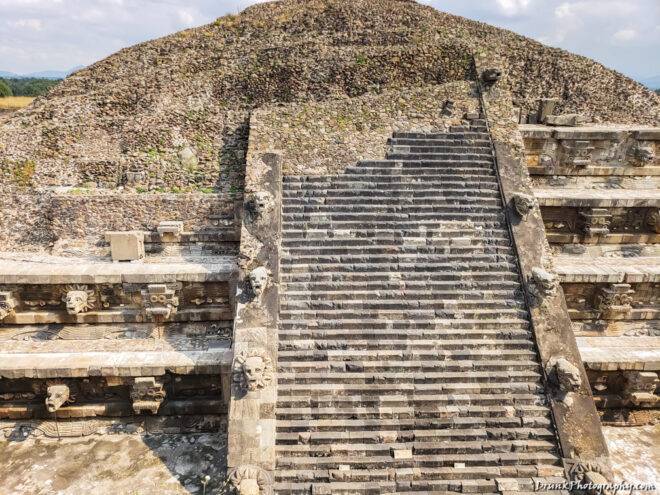
Temple of Quetzalcoatl
Then there is another structure there, which gets called the 3rd Pyramid, and technically is not a pyramid. It’s more of a “temple” and all around it was the meeting area for the people, the Ciudadela, or Citadel in English. The Ciudadela was a gathering space for festivals and ceremonies and 100,000 people could fit in its high walls and sunken area that funnels people towards the center where the “Temple of the Plumed Serpent” (Spaniard translation) or the “Temple of the Feathered Serpent” or the “Temple of Quetzalcoatl” but also “Temple of Ehecatl-Quetzalcoatl” (you might have heard of it by many names) is located. It’s the 3rd largest structure there, dedicated to the Gods, and to one in particular, Quetzalcoatl. It’s more of a temple than a pyramid, so no one refers to it as a pyramid anymore. If you recall from the Folklore, Quetzalcoatl was the 2nd Sun cycle God who ushered in the 2nd era by having the Jaguars kill all the Giants. His character was a combination of a rattlesnake and a bird combined and is how he got his name which in Aztec Nahuatl is derived from “plumped bird” (quetzal) and “serpent” (coatl). This character also existed before the Aztecs, with other civilizations like the Mayans, or Huastecs, who called him “Ehecatl”. If you see Ehecatl written anywhere, that’s normally the God of Wind and Rain in folklore, and he is considered another form of Quetzalcoatl. Quetzalcoatl is a huge God for Mexicans and he became the God of just about everything you could think of by Common Era, especially the creator of life. When you’re looking at the temple, the right side of it (relative to the seating area) has the most definition of the sculptures still intact than does the left side. There are more carvings of serpent heads with feathers adorning them.
By the way, there is another head sculpture there, but that one is up for debate. It’s either the Fire Serpent, Tlaloc the Rain God with bug-eyes (Aztec belief) or a crocodile named Cipactli (the eater of failed attempts to create humans). If look closely at the structures, beneath them you see what looks like flowing water wrapping around the structure running east to west but it’s actually the body of a rattle snake. If you think about, the body connects to the multiple serpent heads you see to the left and right of the stairs portion that separates the left and right sides of the temple. These designs are to be thought of like cave writings that are found around the world. They are telling you stories, so in a way they ware written forms of language, which is where the interpretations of who’s on the temple come from. The easiest to understand is Quetzalcoatl’s feathers are shaped like warped petals of a flower, which helps usher in healthy harvest. The petals also represent sun rays too (remember the concept of life of what the God brought) and just behind them are wavy lines like sun rays. This whole shape is round like the sun. The glasses figure, that’s up for debate but it’s a crocodile to many who believe Quetzalcoatl is the creator of the 5th Sun, otherwise it’s the Aztec Fire Serpent (the face protrudes so it could be either). These debates tie back to seeing both crocodile and fire serpent in other works of art, and the temple itself is part of a ritual calendar. Inside of the temple are gold-colored spheres (made up of oxidized pyrite and walls lined with either hematite, pyrite or magnetite) lined with clay, but no one knows their significance. It’s believed that they were used to illuminate the chambers when light bounced off of the metallic ore. That’s a pretty smart lighting system.
BUILDING OVER OTHERS’ WORK
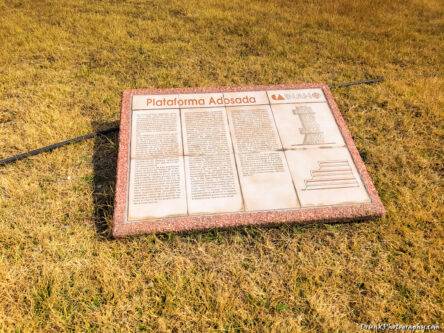
Temple of Quetzalcoatl . Petty as hell!
The more I moved about the location the more I found some really smart thinking when designing this location, also, I saw deliberate attempts to do what I could only describe as pre-Colombian graffiti, in the form of actual building OVER existing structures. I don’t mean modifying existing structure, but like built on top of or in front of structures like “f#ck what you did previously, I’m here NOW” type evidence can be found at this site, and it’s hilarious. If you went to the Temple of Quetzalcoatl you sat on a structure that was placed right in front of the temp. Well that structure you were sitting or standing on was created purposely to OBSTRUCT view of the temple! It’s called the Adosada Platform, it was created much later than the temple, and was designed to block its view. As time progressed and leaders changed their opinion of the Temple of Quetzalcoatl, the temple became not so important to leadership. So they built the Adosada Platform to block the temple because they didn’t have bulldozers back then. So, if you didn’t see it when you were there, you have the platform to blame for this. Then there was another place this happened. There are palace that if you looked closely, someone said “to hell with your steps and statues, I’m going to put a completely platform over your crap and build my own steps on top of that!” If you get to the area in the picture (up top), there is a HOLE that you can look in and see the previous structure that got covered up.
There was also an area that was like living quarters and this place was where it was revealed that people actually lived at the location, and people built on top of what other people previously built too. These were people of privilege. This location also revealed some of the advanced techniques of working with water. Tenochtitlan has a main aqueduct with 2 channels at one point, which the Aztecs have credit for creating. They needed them for farming and bathing, and the rocks in the surrounding areas, which heat up like hot coals in the sun, were placed on top of channels created to funnel the water, which helped to heat that water up. Royals bathed 2 times a day. They also had a “faucet” type system in the living quarters to control the water flow, and with all that sun, they could heat up rocks to create hot water. Brilliant. They also had channels to flush their human wastes down the river.
STRANGE HABITS OF PEOPLE ON TOP OF THE PYRAMIDS
Speaking of Folklore, if you go to this location, I’d recommend that you go on Sunday. Sunday is the day that all of the local Mexicans go to the location, as opposed to other days, because it’s FREE for Mexican residents. Sunday is supposed to be the slowest of days also, but it’s the best day by far. When you make it to the top of the Pyramid of the Sun, you will be see so much space around the outer end of the top to take as many photos as you want. I was surprised with so many people being up top, not too many were taking pictures of the scenery except for other apparent tourists. I saw people up top on the pyramids will stand up there with out-stretched arms, wishing to absorb the energy of the sun. The guide previously told us that the outstretched arms are to be a nod to the RABBIT in the folklore and is what many ancestors did when on top of the mountain. The people doing that up top were people who also had local guides. Nobody seemingly local was doing that. They were pre-occupied with other activities up there. But, as superstition goes, it becomes altered as the stories get passed down, and now, there is a NEW method to gain energy from the Gods, when one is on top of the Pyramids. The way to get that energy is not by raising your arms to the sky, you have to find a MAGICAL hole on the top of the Pyramid of the Sun, knock anyone you see going for that hole out of the way, and start fingering that hole until someone else comes along and knock you out of the way. Seriously, that’s what people are doing up there on top of the Pyramids, fingering a hole because they think that the legends says that’s where the energy is coming from now. So, you can see the split of where one received their folklore by observing the many ways that the people on top of the pyramid were try to gain the energy. Well it turns out that the hole on top of the pyramid was made by a pole that used to be up on top of the pyramid, and it came off a long time ago. That hole is not part of the structural design of the pyramids, but you can’t tell the people anything. They were up there pushing each other and taking pictures of themselves fingering the pyramid, chanting and praying. I was witnessing folklore changing right before my eyes.
As always, the finished products can be found on the main site of www.drunkphotography.com.

